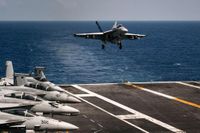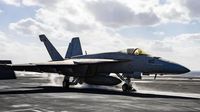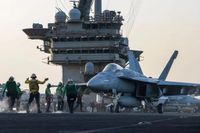The USS Harry S. Truman, a Nimitz-class aircraft carrier of the U.S. Navy, lost an F/A-18E Super Hornet fighter jet and a tow tractor in a mishap that occurred in the Red Sea on Monday, April 28, 2025. The incident unfolded as sailors attempted to tow the aircraft into the hangar bay when the crew lost control, resulting in both the jet and the towing vehicle plunging into the sea.
Fortunately, all personnel involved are accounted for, with only one sailor sustaining minor injuries. The Navy confirmed that the F/A-18E was part of Strike Fighter Squadron 136 and that an investigation into the incident is currently underway.
According to a Navy statement, "The F/A-18E was actively under tow in the hangar bay when the move crew lost control of the aircraft. The aircraft and tow tractor were lost overboard." The sailors towing the aircraft acted quickly to move clear before the jet fell, which likely prevented further injuries.
The loss of this fighter jet, valued at approximately $60 million, adds to a troubling series of incidents involving the Truman. Just last December, another fighter jet from the carrier was mistakenly shot down by the USS Gettysburg, a guided-missile cruiser, during operations in the Red Sea. Both pilots from that incident were rescued safely.
Moreover, in February 2025, the Truman collided with a commercial vessel while operating near the Suez Canal, leading to repairs that took the carrier temporarily out of service. After resuming operations, the Truman has been actively involved in military actions against Houthi rebels in Yemen, launching over 5,500 sorties since its return.
The USS Harry S. Truman has been deployed in the Middle East for several months, participating in intensified military operations against the Iran-backed Houthi group. U.S. Central Command has reported conducting over 800 airstrikes against Houthi targets as part of Operation Rough Rider, aiming to degrade the capabilities of the militant group.
These operations have reportedly resulted in significant losses for the Houthis, including a 69 percent reduction in ballistic missile launches this year compared to 2024. The recent military actions have been part of a broader strategy to counter Iranian influence in the region.
In a statement regarding the ongoing situation, the Navy emphasized that the Harry S. Truman Carrier Strike Group and its embarked air wing remain fully mission capable despite the recent mishaps. The carrier group has been under heightened scrutiny as it continues to face threats, including drone and missile attacks from Houthi forces.
Reports indicate that the Houthi rebels claimed responsibility for a drone and missile attack on the Truman around the time of the incident. They stated that the attack was a response to what they described as U.S. massacres against civilians in Yemen. This escalation in hostilities has prompted the U.S. to bolster its military presence in the region, with Defense Secretary Pete Hegseth extending the Truman's deployment by an additional month.
As part of this increased military readiness, the Pentagon has also dispatched additional aircraft, including B-2 bombers, to Diego Garcia in the Indian Ocean, enhancing the U.S. military's ability to respond to threats from Iran and its proxies.
In the wake of these developments, the Navy has reiterated its commitment to maintaining operational readiness and ensuring the safety of its personnel. The Truman's recent incidents highlight the challenges faced by U.S. forces as they navigate a complex and volatile environment in the Middle East.
The Navy has not yet confirmed whether there will be efforts to recover the lost F/A-18E Super Hornet, which has raised concerns regarding the financial implications of the incident. With military budgets already strained, the loss of such a costly asset adds to the mounting expenses associated with the ongoing conflict against the Houthis.
As the investigation into the incident progresses, the Navy will likely assess not only the immediate causes of the mishap but also broader operational protocols to prevent similar occurrences in the future. The focus will remain on ensuring the safety of personnel and the effective deployment of military assets in a region marked by persistent conflict.
The USS Harry S. Truman, launched on September 13, 1996, is the Navy's ninth nuclear-powered aircraft carrier. It measures 1,092 feet in length and is capable of carrying about 90 aircraft while accommodating over 6,000 crew members. The carrier's capabilities and strategic importance underline its role in U.S. military operations, particularly in the Middle East, where it has been a key player in countering threats from various militant groups.
In summary, the recent mishap involving the USS Harry S. Truman serves as a stark reminder of the dangers inherent in military operations, especially in regions fraught with conflict. As investigations continue and military operations persist, the Navy remains committed to addressing these challenges head-on while ensuring the safety of its personnel and assets.






